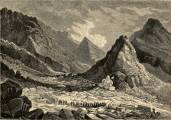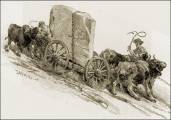


In The Marble Quarries of Vermont
From Popular Mechanics, October 1914.
The greatest marble-producing industry in the world is no longer to
be found in the famous Carrara district of Italy, but in Vermont,
where one of the richest veins in the world stretches in an
irregular line across the state.  So great is the production of marble in this
section that the inhabitants have lost much of their appreciation
of its value, and use it for such humble and utilitarian purposes
as paving, underpinning for barns, hitching posts, stepping stones,
and drinking troughs for horses. This vein is about 57 miles long,
from 1,650 to 2,200 ft. in width, and runs from 375 to 850 ft. in
depth, and from it is being taken in enormous quantities white
marble that is equal to the finest Italian marble, as well as an
endless variety of blue, yellow, green, and jet-black marbles.
So great is the production of marble in this
section that the inhabitants have lost much of their appreciation
of its value, and use it for such humble and utilitarian purposes
as paving, underpinning for barns, hitching posts, stepping stones,
and drinking troughs for horses. This vein is about 57 miles long,
from 1,650 to 2,200 ft. in width, and runs from 375 to 850 ft. in
depth, and from it is being taken in enormous quantities white
marble that is equal to the finest Italian marble, as well as an
endless variety of blue, yellow, green, and jet-black marbles.
For quarrying and finishing the marble, the most up-to-date methods and equipment are used, no part of the work being done by hand that can possibly be done by machinery. Hand methods of drilling, still in vogue in Italy, have been entirely superseded by power-driven drills and channeling machines. The blocks, as they come from the quarry, are handled by derricks and are conveyed in most cases by an inclined railway or a ropeway to the mills, where they are sawed and shaped by power-driven machines, only the last, delicate stage of polishing being done by hand. Blasting is resorted to in removing the decomposed rock overlying the vein, but no blasting, on account of the danger of shattering the marble, is ever done in the actual work of quarrying. The first work is done by the channeling machine, which makes a series of cuts about 6 feet deep along and across the bed, to divide the marble into uniform blocks of a size and shape to be handled by the derricks. The next step is to break out and remove the "keystone." This gives access to the bottoms of the adjacent blocks, and the remainder of the process is comparatively simple. Drills driven by steam or compressed air are then used for drilling holes crosswise through the base of each block so that it can be wedged and broken from the bed easily.
This process is called "gadding," and is repeated until all the blocks are removed and it is necessary to set the channeling machine to work again. In some of the quarries the marble has been taken out to a depth of over 300 feet.In the mill, the blocks are first cut into slabs of the required size and shape by gang saws, which are simply strips of steel carried on a steel frame. As the frame is swung back and forth across the face of the block, a series of cuts is made through the block by the steel strips, sand and water being fed constantly into the cuts to increase the friction. The marble can then be used for many purposes, but if it is to be finished, it is next sent to the rubbing beds where the saw marks and other irregularities are removed. The marble is then ready for the polishing, and this must be done in much the same fashion as it was done by the ancients, as no machine has yet been made that will take the place of the highly skilled labor required for this work. The surface of the marble is rubbed down by hand until it is as smooth as glass, and the final gloss is put on by means of putty and acid.
Commercial use of material within this site is strictly prohibited. It is not to be captured, reworked, and placed inside another web site ©. All rights reserved. Peggy B. and George (Pat) Perazzo.

